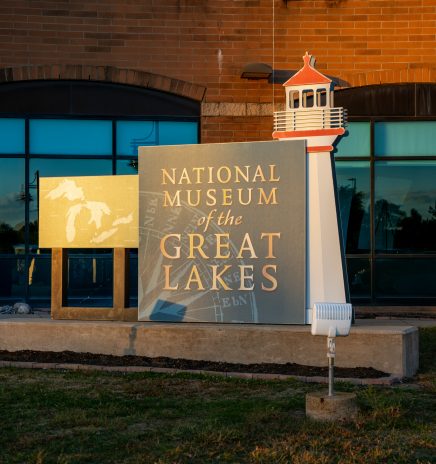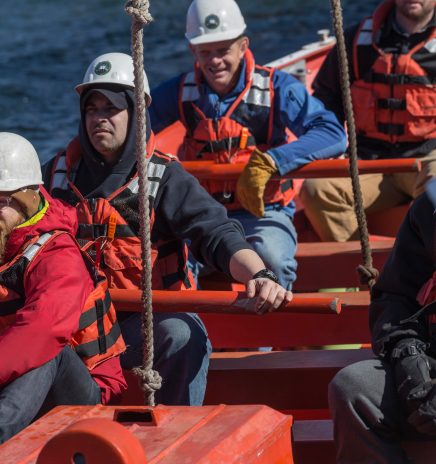Icebreaking Delays: Action Needed to Overcome Disruptions in the Great Lakes Supply Chain
An example is found in the shutdown of 750,000 tons of carrying capacity for iron ore, coal and cement. Twenty voyages were delayed for a total of 325 hours.
The inefficiency introduced into the Great Lakes Navigation System by inadequate U.S. Coast Guard icebreaking resources impacts the carriers, their customers and the entire North American Manufacturing supply chain. The men and women of the U.S. Coast Guard do their best with the resources they’re provided. Unfortunately, they lack the icebreaking capacity necessary to keep the system operating efficiently.
Budget reconciliation legislation being considered in the U.S. Senate would provide the Coast Guard with funding for an additional Great Lakes icebreaker.
Even though the M/V American Century cleared the regulatory check-in point in time to meet the scheduled closing of the U.S. Army Corps locks in Sault Ste. Marie, Mich., it became hindered by ice in the St. Mary’s River. Coast Guard icebreakers were not able to free the vessel in time for its planned transit through the Soo Locks. This delayed the downbound lockages of the last vessels leaving Lake Superior, including the Coast Guard Cutter Biscayne Bay.
With the Alder, normally stationed in Duluth, Minn., on the East Coast for an overhaul, there were no icebreakers on Lake Superior during the lock closure. The ice-induced delays forced the Corps to begin lock dewatering a day later than planned.
Marking Shortages
Typically, the icebreaking season begins on Dec. 15 each year; however, this year Operation Taconite did not begin until Dec. 29. Throughout the scheduled closure of the Soo Locks, from Dec. 15 to Jan. 15, the Coast Guard had four of its nine Great Lakes icebreakers in scheduled overhaul, scheduled maintenance or unscheduled maintenance periods.
At one point in January, five of its eight icebreakers operating on the Great Lakes were simultaneously unavailable due to mechanical failures. A total of 68 icebreaking cutter days were lost due to equipment fires or engine breakdowns.
“The lives of the professional women and men sailing aboard lakers, the safety of the vessels and the protection of the environment depend on adequate Coast Guard icebreakers. In recent years, vessels have been sliced open, forced aground or collided with each other because of inadequate icebreaking resources,” says John Clemons, Great Lakes Maritime Task Force Vice President and a leader of the American Maritime Officers, AFL-CIO.
In addition, one Canadian laker was almost forced aground in the Straits of Mackinac by ice this year. The closest Coast Guard icebreaker was more than 12 hours away. Fortunately, the vessel was able to free itself after struggling for several tense hours.
Even though the Soo Locks officially closed Jan. 15, the last U.S.-flag laker didn’t arrive at its winter layup birth until the end of the month. Vessel delays were experienced in ports and in connecting rivers and waterways.
Why?
In addition to a lack of operational vessels, the Coast Guard is hamstrung by the metrics it uses to allocate resources and determine mission performance standards.
“The Port of Duluth-Superior is the Great Lakes top port by tonnage and one of the nation’s top 20, but the Coast Guard doesn’t consider its waterways as tier I for icebreaking purposes. This is troubling given that Minnesota’s docks along the western edge of Lake Superior provide the iron ore to produce 80% of the nation’s first-pour steel. The Head of the Lakes is a vital link in North America’s domestic steel production supply chain,” says Deb DeLuca, executive director of the Duluth Seaway Port Authority.
A summary of how this metric produces results includes:
- The Coast Guard counts 35 ports on the East Coast as tier 1 waterways. It doesn’t consider any Great Lakes port as that important for icebreaking.
- On the Great Lakes, the Coast Guard only considers four connecting waterways as tier 1, none of which are on Lake Superior.
- The Coast Guard operates 25 icebreaking vessels on the East Coast and only nine on the Great Lakes.
- The Great Lakes Winter Commerce Act (S.576 and H. R.1561) would require the Coast Guard to report to Congress on its plans to improve Great Lakes icebreaking standards and capabilities.
Lakers need to move cargo in the winter to ensure that stockpiles are large enough to sustain the region’s steel mills, power plants and industrial facilities through the 59-day annual closure. During the period, lakers need to make it to their winter homes for maintenance. A few vessels will continue to operate in lakes Huron, Michigan and Erie. They primarily move road salt and petroleum products during the lock closure period.
Adequate icebreaking not only supports the Great Lakes Navigation System, but it also prevents flooding. Last February, we saw extensive flooding because of an ice dam in the St. Clair River. At the time, the lone “heavy” icebreaker operated by the Coast Guard was not available because it was undergoing repairs. We need to build an additional Great Lakes icebreaker and pass the Great Lakes Winter Commerce Act. Both are needed to establish a track line, protect homeowners and keep commerce moving.
Sudden or extreme cold temperatures can upset the natural flow of the rivers that feed into or are part of the Great Lakes. In addition to the Detroit and St. Clair Rivers, this often happens along the Lake Erie shoreline. Flood warnings have already been posted once this year for the St. Clair River and are bound to persist with heavy ice and snow already present in the area.
There’s no question why a second heavy icebreaker is needed to keep houses warm and manufacturing plants open. The only question remaining is: why are the inefficiencies and inequities created by metrics allowed to overtake what is seen and experienced in the Great Lakes year after year?

From History Keepers to Industry Builders at the National Museum of the Great Lakes
At the National Museum of the Great Lakes, our mission is to preserve, share and celebrate the past, present and future of the Great Lakes story. That story is vast,... Read More

Building a Framework To Address Workforce Shortages
The United States Merchant Marine is at a crossroads – one that could define the future of our maritime sector for generations. As workforce shortages collide with increased global competition,... Read More

